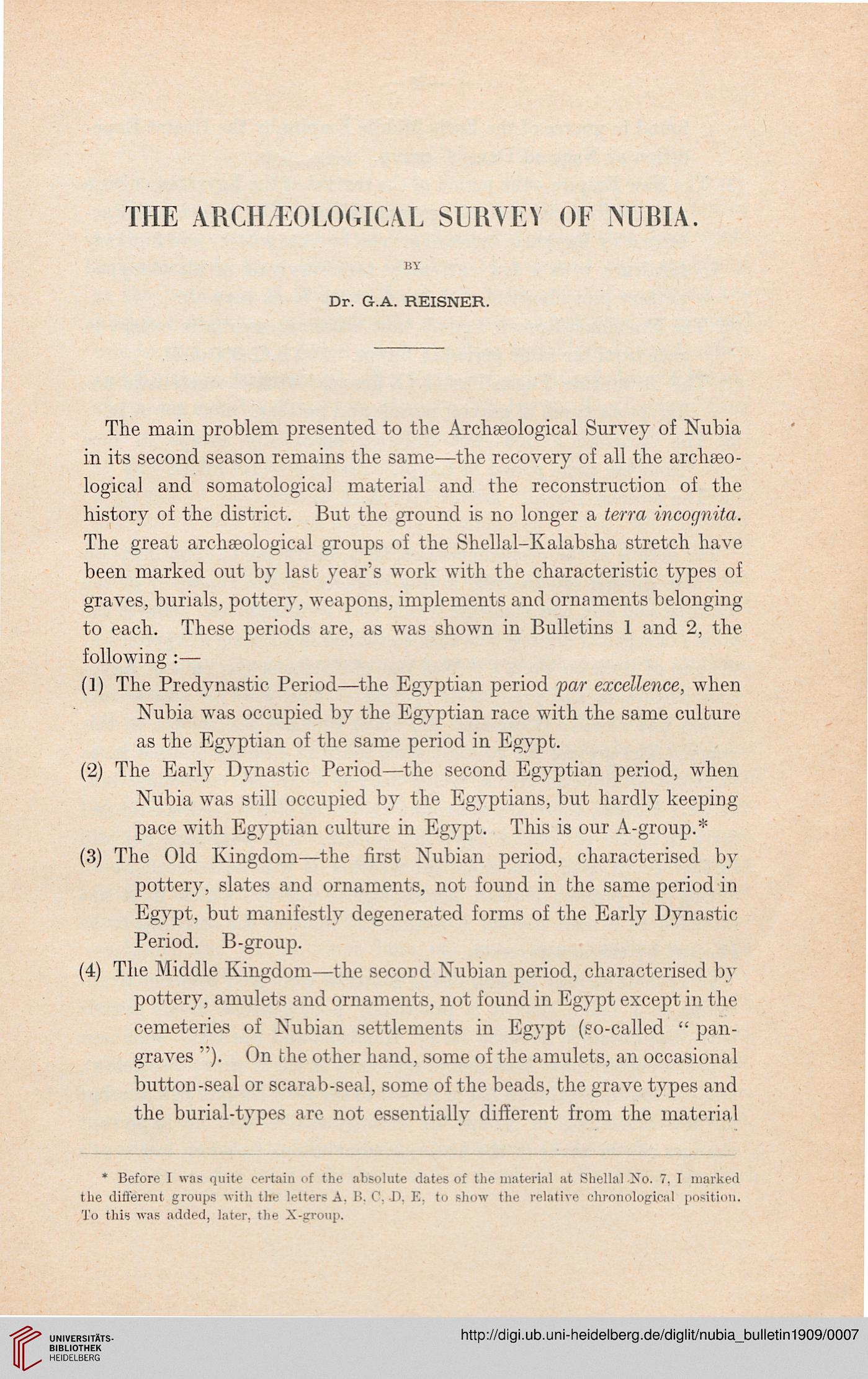THE ARCHAEOLOGICAL SURVEY OF NUBIA.
BY
Dr. G.A. REISNER.
The main problem presented to the Archaeological Survey of Nubia
in its second season remains the same—the recovery of all the archaeo-
logical and somatological material and the reconstruction of the
history of the district. But the ground is no longer a terra incognita.
The great archaeological groups of the Shell al-Kalabsha stretch have
been marked out by last year's work with the characteristic types of
graves, burials, pottery, weapons, implements and ornaments belonging
to each. These periods are, as was shown in Bulletins 1 and 2, the
following :—
(1) The Predynastic Period—the Egyptian period far excellence, when
Nubia was occupied by the Egyptian race with the same culture
as the Egyptian of the same period in Egypt.
(2) The Early Dynastic Period—the second Egyptian period, when
Nubia was still occupied by the Egyptians, but hardly keeping
pace with Egyptian culture in Egypt. This is our A-group.*
(3) The Old Kingdom—the first Nubian period, characterised by
pottery, slates and ornaments, not found in the same period in
Egypt, but manifestly degenerated forms of the Early Dynastic
Period. B-group.
(4) The Middle Kingdom—the second Nubian period, characterised by
pottery, amulets and ornaments, not found in Egypt except in the
cemeteries of Nubian settlements in Egypt (so-called " pan-
graves "). On the other hand, some of the amulets, an occasional
button-seal or scarab-seal, some of the beads, the grave types and
the burial-types are not essentially different from the material
* Before I was quite certain of the absolute dates of the material at Shellal No. 7. I marked
the different groups with the letters A. B, C D. E. to show the relative chronological position.
To this was added, later, the X-jrroup.
BY
Dr. G.A. REISNER.
The main problem presented to the Archaeological Survey of Nubia
in its second season remains the same—the recovery of all the archaeo-
logical and somatological material and the reconstruction of the
history of the district. But the ground is no longer a terra incognita.
The great archaeological groups of the Shell al-Kalabsha stretch have
been marked out by last year's work with the characteristic types of
graves, burials, pottery, weapons, implements and ornaments belonging
to each. These periods are, as was shown in Bulletins 1 and 2, the
following :—
(1) The Predynastic Period—the Egyptian period far excellence, when
Nubia was occupied by the Egyptian race with the same culture
as the Egyptian of the same period in Egypt.
(2) The Early Dynastic Period—the second Egyptian period, when
Nubia was still occupied by the Egyptians, but hardly keeping
pace with Egyptian culture in Egypt. This is our A-group.*
(3) The Old Kingdom—the first Nubian period, characterised by
pottery, slates and ornaments, not found in the same period in
Egypt, but manifestly degenerated forms of the Early Dynastic
Period. B-group.
(4) The Middle Kingdom—the second Nubian period, characterised by
pottery, amulets and ornaments, not found in Egypt except in the
cemeteries of Nubian settlements in Egypt (so-called " pan-
graves "). On the other hand, some of the amulets, an occasional
button-seal or scarab-seal, some of the beads, the grave types and
the burial-types are not essentially different from the material
* Before I was quite certain of the absolute dates of the material at Shellal No. 7. I marked
the different groups with the letters A. B, C D. E. to show the relative chronological position.
To this was added, later, the X-jrroup.





